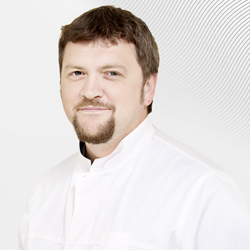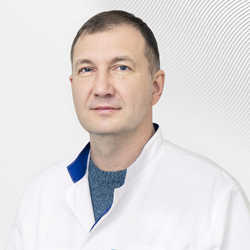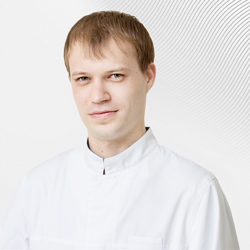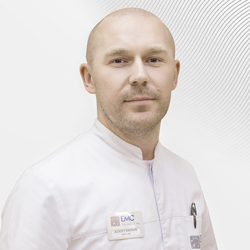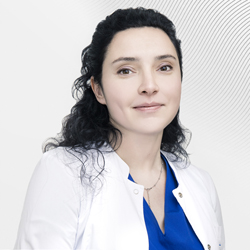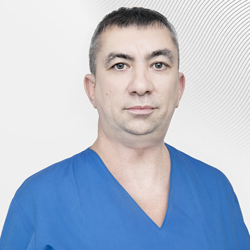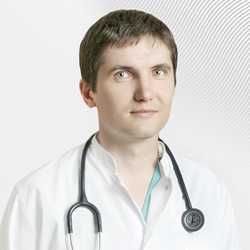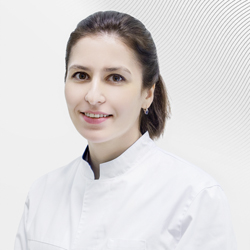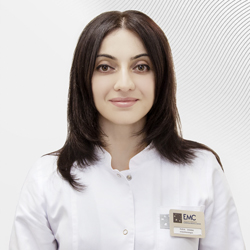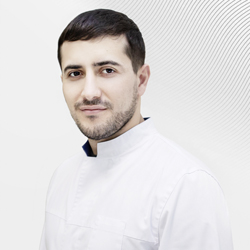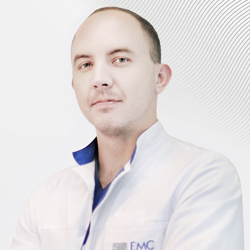
Anesthesiology
Anaesthesia can be general, regional or local. During general anaesthesia, the patient's sleep is maintained by the constant introduction of sleep-inducing medication with accurate dosing apparatus. Drugs can be administered intravenously before surgery via a plastic intravenous catheter, or inhaled through a mask. The absence of pain is provided by analgesics, which are also introduced throughout the operation.
The patient's breathing during general anaesthesia may be independent, but usually its adequacy is supported by a special breathing apparat us that can "adapt" to the rhythm and depth of the patient's breathing, providing comfort. During a short and simple operation, the anaesthetist uses a laryngeal mask through which the patient breathes a mixture of oxygen and air and anaesthetic gases. For longer operations requiring complete muscle relaxation, muscle relaxants are used, and endotracheal anaesthesia is carried out. With sleep medication, a thermoplastic tube with a special cuff that completely protects the lungs and allows artificial ventilation is introduced into the airways of the patient. Sleep and pain relief are maintained, as previously mentioned, by the constant introduction of sleeping medication and painkillers.
In the more complex group of patients, for example, with concomitant diseases of the cardiovascular system, necessary drugs are introduced during anaesthesia that support the work of the heart and normalize blood pressure. In patients with diabetes, blood sugar levels are controlled. If necessary, during surgery, any laboratory investigation can be completed in a very short time.
Regional anaesthesia can anaesthetise separate areas of the body. The most well-known for patients is spinal epidural anaesthesia, when a small amount of local anaesthetic blocks pain and motor nerve impulses of the lower body. With this type of anaesthesia, the majority of operations are performed on the lower limbs. And for patients of older age groups, this is an alternative method of anaesthesia for prosthetic knee and hip joints.
Regional anaesthesia is also used during operations on the upper limbs. A special device precisely determines the location of the nerve plexus, for example, in the neck, armpit or individual nerves in the forearm and hand, and a local anaesthetic is introduced. After 20-30 minutes, the arm loses its sensitivity and ability to move.
The nerves are blocked for 2-3 hours, and then all usual feeling gradually recovers. The course of any regional anaesthesia may be supported by light medical sleep, eliminating the "presence" of the patient during surgery. This issue is discussed during consultation with an anaesthesiologist before surgery. At the request of the patient, sleeping medication is not introduced, and he will be able to watch the surgery on a monitor, without experiencing any discomfort.
Regional anaesthesia is also used for analgesia in the postoperative period, most often during operations in the area of the knee, shin and foot, providing no pain for 8-12 hours.
Local anaesthesia is now only used for small operations on the surface of the body. A type of local anaesthesia is an application of anaesthetic ointment on the skin, and after 30-40 minutes it is possible, for example in children, to produce painless puncture veins for blood samples.
Before each operation is carried out, there must be a consultation with a doctor and an anaesthesiologist to discuss what kind of anaesthesia is suitable for each individual patient, taking into account his health, type of operation and personal preferences.
Risks of anaesthesia
Today, anaesthesia is relatively safe, although like all other medical procedures, it has certain risks. Life-threatening complications, such as cardiac, respiratory, and severe allergic reactions, are very rare.The risks of anaesthesia is increased if:
- The patient has any chronic disease, such as hypertension, coronary heart disease, asthma, diabetes, etc., and if these diseases are well compensated, the risk increases slightly
- The patient is allergic to any drugs
- The patient smokes, abuses alcohol, or uses drugs
- The patient does not adhere to recommendations in preparation for surgery and anaesthesia, for example, could not resist the required time interval to limit food intake, or did not agree medication intake with the anaesthesiologist.
Dangers associated with general anaesthesia:
- As during general anaesthesia the protective reflexes are inhibited, there is a danger of gastric contents entering the airways and, consequently, a life-threatening condition occurring. Therefore, for 6 hours before the operation, one must not eat, and for 4 hours before the operation, stop intake of water or other beverages, chewing gum and smoking. If the patient does not follow this rule, for safety, the operation is delayed or cancelled.
- It is important to tell the anaesthesiologist about the loose teeth or dentures, as endotracheal anaesthesia with an endotracheal tube may cause potential damage to teeth or vocal cords.
- In rare cases, in the early postoperative period nausea and vomiting may be experienced, which is associated with the individual response to anaesthesia drugs.
- During anaesthesia, muscle tone is decreased, so during long operations, there may be positional compression of the nerves, which can lead to reduced sensitivity in some parts of the body lasting up to several weeks.
Dangers associated with regional anaesthesia:
- When conducting spinal or epidural anaesthesia, blood pressure may lower, and dizziness, nausea and shortness of breath may occur. If you experience these symptoms, immediately notify the anaesthesiologist or anaesthetist who will take the necessary steps to improve your condition.
- After an operation carried out under spinal or epidural anaesthesia, reduced feeling is maintained in the lower limbs for several hours, and emptying the bladder may also be hampered; if necessary, a catheter is attached to the bladder.
- After spinal anaesthesia, there may be a headache. This rare complication may require several days of bed rest and pain medication.
Discussion with the anaesthetist
Anaesthesia is always preceded by a discussion with an anaesthesiologist. If you have any questions, be sure to ask them at this time! You will be given a questionnaire to complete, where all information about your health, past and currently available should be noted as accurately as possible and in detail, including diseases, as well as previously used and currently used medications. Also information about previous operations, possible allergies to medications, and your habits are required (exercise, smoking, drinking, etc.).Prior to surgery, you must sign a consent form for surgery and anaesthesia.
How do you prepare for surgery?
Before surgery and anaesthesia:- Tell your doctor about all changes in health, and particularly for women, the start of menstruation or possible pregnancy.
- Avoid alcohol and smoking for 12 hours before the visit to the clinic.
- Prepare for possible hospitalization of more than one day.
On the day of surgery:
- Do not eat food for 6 hours or drink for 4 hours before surgery.
- Do not use make-up, nail polish, or wear contact lenses. Painted or artificial fingernails can hinder the work of the finger sensor tracking oxygen.
- Medications prescribed by the anaesthesiologist should be taken with no more than one sip of water.
- On the morning of surgery, take a shower.
- You should attend hospital at the time specified.
- Immediately before the operation, change into the special clothing issued to you by the nurse.
- Remove and return to the nurse in the department all jewellery, rings, glasses, contact lenses and dentures. Immediately before the operation, go to the toilet.
- If necessary, bring to the operating your hearing aid or inhaler used for asthma.
After surgery
Recovery from anaesthesia occurs in the recovery room, where medical staff monitors breathing, heart rate and blood pressure. Pain is also under control. If necessary, pain medications are introduced, and oxygen is supplied. If spinal anaesthesia was performed, the restoration of mobility and sensation in the lower limbs is also monitored. You will only be taken to a hospital ward after waking up and if in a satisfactory condition.- Depending on the complexity of the operation, postoperative treatment in an intensive care unit may require.
- After surgery, wounds may be painful. To prevention or treatment, you will be given painkillers. Different people, even with the same operations, experience very different pain intensity. Severe pain contributes to sleep disruption, fear and irritability.
The faster pain is controlled, the faster you recover from surgery. There is no need to endure pain! If you feel pain, tell the nurse. - Even if the operation is on an outpatient basis and you can go home in the evening, you can only leave the hospital with permission of the anaesthetist or surgeon. It is essential that you are accompanied by a friend or relative (a driver may not accompany children).
- All specific recommendations will be given to you prior to discharge from the hospital.
On the first day after surgery is not recommended:
- To consume alcohol, sleep-inducing or psychotropic substances, or overeat in the evening after surgery.
- Drive a motor vehicle or operate another potentially dangerous device.
- Be in situations that require attention and making important decisions.
- It is preferable not to remain alone in the first day after surgery.
| Name | Price, € | Price, ₽ | Code |
| Oncologist consultation | 309 € | 30 574 ₽ | CS31 |
| Consultation before chemotherapy for malignant tumors and doctor's supervision during infusion treatment | 253 € | 25 033 ₽ | CS58 |
| Oncologist and palliative care specialist consultation | 405 € | 40 073 ₽ | CS59 |
| Hematologist consultation before chemotherapy | 253 € | 25 033 ₽ | CS98 |
| Radiation-Oncologist consultation | 309 € | 30 574 ₽ | CS_RT |
| Daily follow-up/consultation by treating doctor in oncology in-patient department | 309 € | 30 574 ₽ | CS139 |
| Oncologist remote consultation | 309 € | 30 574 ₽ | RCS31 |
| Oncologist and palliative care specialist remote consultation | 405 € | 40 073 ₽ | RCS59 |
| Radiologist-oncologist remote consultation | 309 € | 30 574 ₽ | RCS1_RT |
| Remote interpretation of PET-CT scan results from another clinic | 220 € | 21 768 ₽ | RCS_PET |

